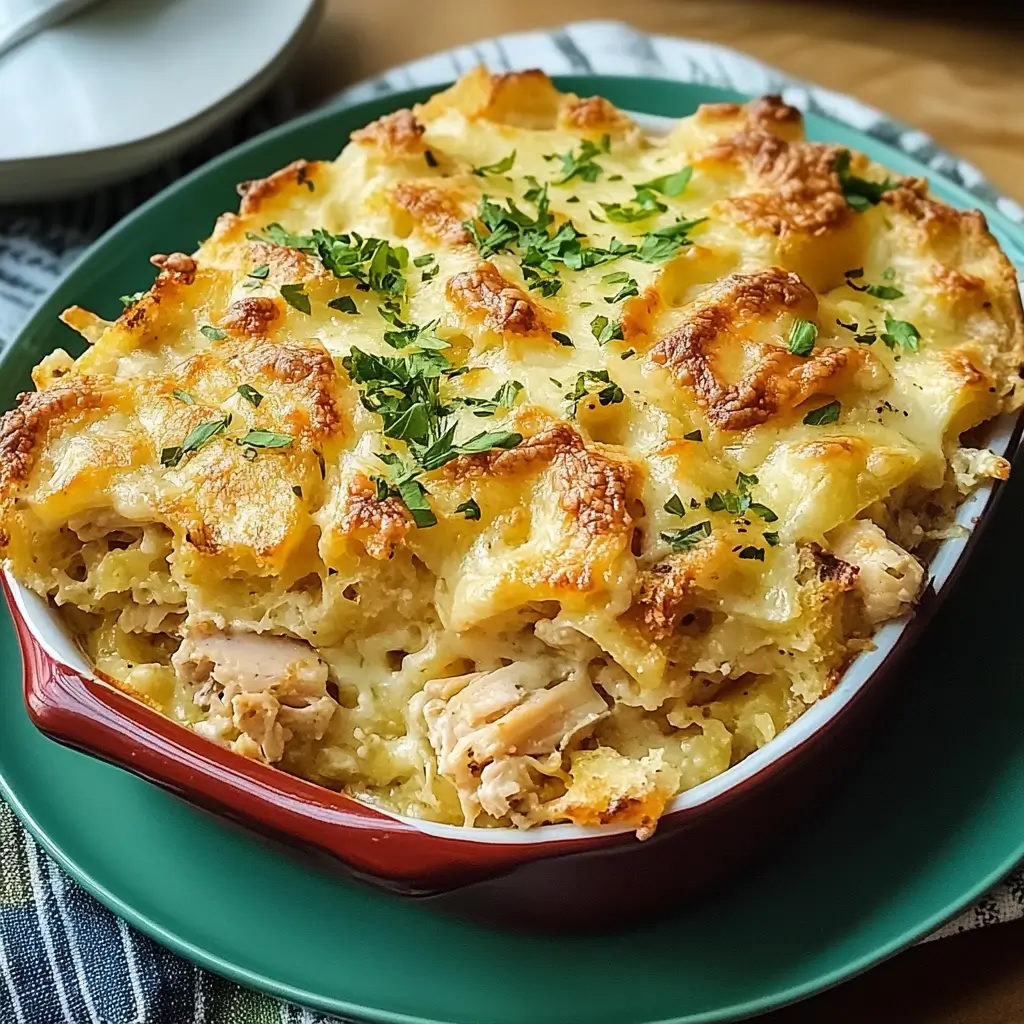There are certain dishes that instantly transport you back to childhood, evoking feelings of warmth, comfort, and uncomplicated joy. For me, the humble tuna melt holds a special place in that nostalgic pantheon. But as much as I adore a classic tuna melt sandwich, sometimes you crave that familiar flavor profile in a form that’s a bit more substantial, a bit more shareable, and undeniably more comforting – especially on a chilly evening. That’s where the Tuna Melt Casserole steps in, transforming a beloved lunchtime staple into a hearty family dinner. When I first made this casserole, I wasn’t sure what to expect. Would it capture the essence of a tuna melt? Would my family, notorious for their varying palates, embrace it? The answer, thankfully, was a resounding yes! The layers of creamy tuna filling, perfectly melted cheese, and satisfyingly crunchy topping were an instant hit. Even my pickiest eater went back for seconds, declaring it “the best tuna thing” he’d ever had. This Tuna Melt Casserole is not just a meal; it’s an experience. It’s the perfect dish for busy weeknights, potlucks with friends, or simply when you need a dose of pure, unadulterated comfort food. Get ready to rediscover the tuna melt in a whole new, deliciously satisfying way.
Ingredients
The beauty of a Tuna Melt Casserole lies in its simplicity and the readily available ingredients. You likely have many of these pantry staples on hand already, making it a fantastic option for a last-minute dinner. The key to a truly exceptional casserole is using quality ingredients and understanding how each component contributes to the overall flavor and texture. Let’s break down each ingredient and discuss why it’s essential, along with some helpful tips and potential substitutions.
- Tuna: The star of the show! For this casserole, canned tuna packed in water is generally recommended. Draining it well is crucial to prevent a watery casserole. You can use either chunk light tuna or solid white tuna, depending on your preference. Chunk light tuna, often skipjack or yellowfin, has a stronger “tuna” flavor and a flakier texture, which some prefer in casseroles. Solid white tuna, typically albacore, has a milder flavor and firmer texture. For a richer flavor, you could even use tuna packed in olive oil, but be sure to drain it thoroughly and consider reducing the amount of mayonnaise slightly. For a healthier twist, look for tuna caught using sustainable fishing practices.
- Mayonnaise: Mayonnaise is the binder and flavor enhancer for the tuna mixture. It adds creaminess and tanginess that complements the tuna perfectly. Full-fat mayonnaise provides the richest flavor and texture, but you can also use light mayonnaise or even Greek yogurt mixed with a touch of Dijon mustard for a healthier alternative. Avoid using “salad dressing” like Miracle Whip, as its sweetness can overpower the savory flavors of the casserole. Experiment with different flavored mayonnaises for a unique twist – a garlic aioli mayonnaise or a spicy sriracha mayonnaise could add an exciting dimension.
- Celery: Finely diced celery adds a crucial element of crunch and freshness to the tuna mixture. It balances the richness of the mayonnaise and tuna and provides a pleasant textural contrast. If you don’t have celery, you can substitute it with finely diced cucumber for a similar refreshing crunch, or even water chestnuts for a more subtle texture.
- Onion (or Shallots): Onion provides aromatic depth and savory flavor to the casserole. Yellow onion is a classic choice, offering a mild, sweet flavor when cooked. You can also use white onion for a sharper bite or shallots for a more delicate and slightly sweeter flavor. Finely dice the onion so it cooks evenly and blends seamlessly into the tuna mixture. For those who are sensitive to raw onion, consider sautéing the diced onion in a little butter or olive oil until softened before adding it to the tuna mixture. This mellows out the onion flavor and adds an extra layer of richness.
- Cheese: Cheese is what truly transforms a tuna melt into a decadent casserole. A combination of cheeses is often best for a complex flavor and melting texture. Cheddar cheese is a must-have for that classic tuna melt flavor. Sharp cheddar provides a bolder, more pronounced cheese flavor, while mild cheddar is more mellow and kid-friendly. Monterey Jack cheese or Pepper Jack cheese (for a spicy kick) can be added for extra meltiness and flavor. Mozzarella cheese is another excellent choice for its incredible melt and mild flavor. Consider using a blend of cheddar and mozzarella for the perfect balance of flavor and texture. Pre-shredded cheese is convenient, but freshly grated cheese will melt more smoothly and have a superior flavor.
- Cream of Mushroom Soup: Cream of mushroom soup is the creamy base that holds the casserole together and adds richness and depth of flavor. It creates that classic casserole creaminess that we all love. You can use regular cream of mushroom soup or “reduced sodium” for a healthier option. For those who are not fans of mushrooms, cream of celery soup or cream of chicken soup can be used as substitutes. For a richer, more homemade flavor, you can even make your own cream sauce from scratch using butter, flour, milk, and seasonings.
- Milk (or Broth): A little milk or broth is often added to the cream of mushroom soup to thin it out slightly and create a smoother, more pourable sauce. Whole milk or 2% milk will provide the richest flavor, but skim milk or non-dairy milk alternatives like almond milk or oat milk can also be used. Chicken broth or vegetable broth can be used instead of milk for a more savory flavor profile.
- Bread, Pasta, or Potatoes (Casserole Base): The base of the casserole provides substance and structure. You have several options here, each offering a different texture and flavor.
- Bread: Cubed bread is a classic casserole base. Day-old bread works best as it is slightly drier and will absorb the sauce without becoming soggy. Use white bread, whole wheat bread, sourdough bread, or even crusty French bread. You can toast the bread cubes lightly before adding them to the casserole for extra texture and flavor.
- Pasta: Elbow macaroni, rotini, or penne are popular pasta choices for casseroles. Cook the pasta al dente according to package directions, as it will continue to cook in the oven. Overcooked pasta can become mushy in the casserole.
- Potatoes: Cubed cooked potatoes (like Russet or Yukon Gold) can create a heartier, more potato-based casserole. You can boil, bake, or roast the potatoes until tender before dicing them and adding them to the casserole.
- Breadcrumbs or Crushed Potato Chips (Topping): The topping adds a crucial element of crunch and texture to the casserole.
- Breadcrumbs: Panko breadcrumbs or Italian breadcrumbs work wonderfully. You can toss the breadcrumbs with melted butter or olive oil for extra richness and browning.
- Crushed Potato Chips: Plain potato chips or kettle-cooked potato chips add a salty, satisfying crunch. Crush them coarsely and sprinkle them over the casserole before baking. Ritz crackers or other buttery crackers can also be crushed and used as a topping.
- Seasonings: Don’t underestimate the power of seasonings! Salt and pepper are essential for enhancing all the flavors. Garlic powder or onion powder can boost the savory notes. Dried dill, dried parsley, or dried thyme add a touch of herbaceousness. A pinch of paprika can add color and a subtle smoky flavor. Hot sauce or red pepper flakes can be added for a touch of heat. Taste and adjust the seasonings as needed to create a well-balanced and flavorful casserole.
Here’s a typical ingredient list for a Tuna Melt Casserole:
- 2 cans (5 ounces each) tuna in water, drained
- 1/2 cup mayonnaise
- 1/4 cup finely diced celery
- 1/4 cup finely diced onion or shallot
- 1 1/2 cups shredded cheddar cheese, divided
- 1 (10.75 ounce) can condensed cream of mushroom soup
- 1/4 cup milk or chicken broth
- 4 cups cubed bread, cooked pasta, or cooked diced potatoes
- 1/2 cup breadcrumbs or crushed potato chips
- 2 tablespoons melted butter or olive oil (if using breadcrumbs)
- Salt and pepper to taste
- Optional seasonings: garlic powder, onion powder, dried dill, paprika, hot sauce
Instructions
Creating a Tuna Melt Casserole is surprisingly straightforward. It’s essentially a matter of combining the ingredients, layering them in a baking dish, and baking until bubbly and golden brown. Following these step-by-step instructions will ensure a perfectly cooked and delicious casserole every time.
Step 1: Preheat the Oven and Prepare the Baking Dish
- Preheat your oven to 375°F (190°C). This temperature allows the casserole to cook through evenly and the cheese to melt beautifully without burning the topping.
- Grease a 9×13 inch baking dish with butter, cooking spray, or olive oil. This prevents the casserole from sticking to the dish and makes serving easier. You can also use a slightly smaller or larger dish, adjusting the baking time accordingly. A smaller dish will result in a thicker casserole, while a larger dish will create a thinner layer.
Step 2: Prepare the Tuna Mixture
- In a large bowl, combine the drained tuna, mayonnaise, diced celery, and diced onion (or shallot). Use a fork to gently flake the tuna and mix everything together until well combined.
- Season the tuna mixture with salt and pepper. Taste and adjust the seasonings as needed. Add any optional seasonings like garlic powder, onion powder, dried dill, paprika, or hot sauce to your liking. Remember to season generously, as the flavors will mellow out during baking.
- Stir in 1 cup of the shredded cheddar cheese. This cheese will melt into the tuna mixture, adding creaminess and flavor throughout the casserole. Reserve the remaining 1/2 cup of cheese for topping.
Step 3: Prepare the Cream Sauce
- In a separate bowl, whisk together the condensed cream of mushroom soup and milk (or chicken broth). Whisk until smooth and creamy. This thins out the soup slightly, creating a pourable sauce that will coat the casserole ingredients.
- If you are using homemade cream sauce instead of condensed soup, prepare it according to your recipe. Ensure it is smooth and creamy before proceeding.
Step 4: Assemble the Casserole
- Spread the chosen casserole base (cubed bread, cooked pasta, or cooked diced potatoes) evenly in the prepared baking dish. Create a single layer of your base, ensuring it covers the bottom of the dish. If using bread cubes, you may need to gently press them down to create a more even layer.
- Pour the cream sauce evenly over the base layer. Make sure the sauce distributes evenly and coats the base ingredients.
- Spoon the tuna mixture evenly over the cream sauce layer. Spread it out to create a uniform layer over the sauce.
- Sprinkle the remaining 1/2 cup of shredded cheddar cheese evenly over the tuna mixture. This cheese will melt and create a golden, cheesy topping.
- If using breadcrumbs for the topping, toss them with the melted butter or olive oil in a small bowl. This will help them brown and crisp up in the oven.
- Sprinkle the breadcrumbs or crushed potato chips evenly over the cheese layer. Distribute the topping evenly for maximum crunch in every bite.
Step 5: Bake the Casserole
- Bake in the preheated oven for 25-30 minutes, or until the casserole is heated through, bubbly around the edges, and the topping is golden brown. The cheese should be melted and gooey, and the casserole should be heated all the way through.
- If the topping is browning too quickly, you can loosely tent the casserole with aluminum foil for the last 10-15 minutes of baking. This will prevent the topping from burning while allowing the casserole to continue cooking through.
Step 6: Broil for Extra Browning (Optional)
- For an extra golden brown and crispy topping, you can broil the casserole for the last 1-2 minutes of baking. Keep a close eye on it while broiling, as it can burn quickly. Broil just until the topping is nicely browned and bubbly.
Step 7: Let it Rest and Serve
- Remove the casserole from the oven and let it rest for 5-10 minutes before serving. This allows the casserole to set slightly and makes it easier to serve. It also prevents burning your mouth on extremely hot cheese.
Step 8: Enjoy!
- Serve the Tuna Melt Casserole hot and enjoy its cheesy, comforting goodness! Pair it with your favorite side dishes (see “How to Serve” section below) for a complete and satisfying meal.
Nutrition Facts
Understanding the nutritional content of your meals is important for making informed dietary choices. Please remember that the nutrition facts provided below are estimates and can vary based on the specific ingredients used and portion sizes. This information is intended as a general guideline.
Serving Size: Approximately 1/6 to 1/8 of the casserole (depending on how you cut it)
Approximate Calories per Serving: 350-450 calories
Approximate breakdown per serving (These values are estimates and will vary):
- Protein: 20-25 grams
- Fat: 20-25 grams (This will vary depending on the type of mayonnaise and cheese used. Using light mayonnaise and reduced-fat cheese will lower the fat content.)
- Carbohydrates: 20-30 grams (This will vary depending on the base used – bread, pasta, or potatoes – and the type of breadcrumbs or chips for topping.)
Key Nutritional Highlights (per serving, approximate):
- Good source of protein: Tuna is a lean protein source, contributing to muscle building and satiety.
- Source of calcium: Cheese provides calcium, which is important for bone health.
- May contain sodium: Canned soup and processed cheeses can be high in sodium. Using reduced-sodium soup and being mindful of added salt can help manage sodium intake.
- Moderate in fat: The fat content comes primarily from mayonnaise and cheese. Choosing lighter versions of these ingredients can reduce the fat content.
Important Notes:
- These nutrition facts are estimates. For more precise information, you can use online nutrition calculators or apps, inputting the exact brands and quantities of ingredients you use.
- Serving sizes can vary. Be mindful of your portion sizes to manage calorie and nutrient intake.
- This casserole can be part of a balanced diet when consumed in moderation and paired with healthy side dishes like salads or vegetables.
Preparation Time
One of the great advantages of Tuna Melt Casserole is its relatively quick preparation time. It’s a perfect option for weeknight dinners when time is limited but you still want a satisfying and flavorful meal.
Prep Time: Approximately 20-25 minutes
- This includes:
- Draining the tuna
- Chopping celery and onion
- Shredding cheese (if using block cheese)
- Mixing the tuna mixture
- Preparing the cream sauce
- Assembling the casserole in the baking dish
- Preparing the breadcrumb topping (if using)
Cook Time: 25-30 minutes
- This is the time the casserole spends baking in the oven until heated through, bubbly, and golden brown.
Total Time: Approximately 45-55 minutes
- From start to finish, you can have a delicious and comforting Tuna Melt Casserole on the table in under an hour. This makes it a fantastic choice for busy weeknights or when you need a quick and easy meal.
Tips to Speed Up Prep Time:
- Use pre-shredded cheese: This saves time on grating cheese.
- Use pre-diced celery and onion: Many grocery stores sell pre-cut vegetables in the produce section.
- Have your bread/pasta/potatoes cooked in advance: If using pasta or potatoes, cook them ahead of time so they are ready to assemble the casserole.
- Organize your ingredients: Having all your ingredients prepped and ready to go before you start assembling the casserole will streamline the process.
How to Serve
Tuna Melt Casserole is a hearty and satisfying dish on its own, but pairing it with complementary side dishes can elevate the meal and create a well-rounded dining experience. Consider these serving suggestions to create a delicious and balanced meal:
- Fresh Green Salad:
- A simple green salad with a light vinaigrette dressing provides a refreshing contrast to the richness of the casserole.
- Lettuce, mixed greens, spinach, or arugula all work well.
- Add vegetables like cucumbers, tomatoes, bell peppers, or shredded carrots for extra color and nutrients.
- Coleslaw:
- Creamy or vinegar-based coleslaw offers a cool and crunchy counterpoint to the warm, cheesy casserole.
- The slight sweetness of coleslaw also complements the savory flavors of the tuna melt.
- Steamed or Roasted Vegetables:
- Steamed broccoli, green beans, asparagus, or carrots provide a healthy and colorful side dish.
- Roasted vegetables like Brussels sprouts, cauliflower, or root vegetables add a deeper flavor and heartiness.
- Season vegetables simply with salt, pepper, and a drizzle of olive oil or lemon juice.
- Fruit Salad or Fresh Fruit:
- A light and refreshing fruit salad or a platter of fresh fruit (like grapes, melon, berries, or apple slices) offers a sweet and juicy contrast to the savory casserole.
- Fruit cleanses the palate and provides a healthy dose of vitamins and fiber.
- Pickles or Olives:
- A side of dill pickles, sweet pickles, or olives adds a tangy and briny element that cuts through the richness of the casserole.
- These are simple yet effective palate cleansers.
- Chips or Crackers (if not using chip topping):
- If you didn’t use crushed potato chips as a topping, you can serve some potato chips or crackers on the side for extra crunch.
- Tortilla chips, pita chips, or even baguette slices would also work well.
- Tomato Soup (for a “soup and sandwich” vibe):
- For a truly comforting meal, serve a small bowl of tomato soup alongside the Tuna Melt Casserole.
- This combination echoes the classic tuna melt sandwich and soup pairing.
Serving Temperature and Garnishes:
- Serve the Tuna Melt Casserole hot straight from the oven.
- Garnish with fresh parsley or dill for a pop of color and freshness.
- A sprinkle of paprika on top can also add visual appeal.
- Serve individual portions using a spatula or large spoon.
Additional Tips for Tuna Melt Casserole Perfection
Want to take your Tuna Melt Casserole to the next level? These additional tips and tricks will help you create a truly outstanding and memorable dish:
- Cheese Variety is Key: Don’t be afraid to experiment with different cheese combinations. While cheddar is essential for that classic tuna melt flavor, try adding other cheeses like Monterey Jack for meltiness, Gruyere for nuttiness, or Pepper Jack for a spicy kick. A blend of two or three cheeses will create a more complex and flavorful casserole.
- Elevate Your Breadcrumb Topping: Instead of plain breadcrumbs, try using panko breadcrumbs for extra crunch. Toss the breadcrumbs with melted butter or olive oil, and consider adding grated Parmesan cheese, garlic powder, or dried herbs like Italian seasoning or thyme to the breadcrumb mixture for added flavor. You can also use crushed Ritz crackers or even fried onions for a unique and delicious topping.
- Add Vegetables to the Tuna Filling: Boost the nutritional value and flavor of your casserole by adding extra vegetables to the tuna mixture. Finely diced bell peppers (red, green, or yellow), chopped spinach, or cooked peas can be incorporated into the tuna mixture. Sautéing these vegetables lightly before adding them can enhance their flavor.
- Make it Ahead of Time: Tuna Melt Casserole is a great make-ahead dish. You can assemble the casserole completely (up to the point of baking) and store it covered in the refrigerator for up to 24 hours. When ready to bake, simply add about 10-15 minutes to the baking time to ensure it is heated through. This is perfect for meal prepping or for easy entertaining.
- Control the Moisture: To prevent a watery casserole, make sure to drain the tuna thoroughly. If using frozen vegetables, thaw them completely and squeeze out any excess moisture before adding them to the tuna mixture. Also, avoid adding too much milk to the cream of mushroom soup – you want it to be creamy but not too thin. If your casserole does seem a bit watery after baking, you can carefully drain off any excess liquid before serving.
FAQ Section: Your Tuna Melt Casserole Questions Answered
Got questions about making the perfect Tuna Melt Casserole? Here are answers to some frequently asked questions to help you succeed:
Q1: Can I use a different type of soup instead of cream of mushroom?
A: Yes, absolutely! If you are not a fan of mushrooms, or if you simply want to try a different flavor profile, you can substitute cream of mushroom soup with other condensed cream soups. Cream of celery soup, cream of chicken soup, or even cream of cheddar cheese soup are all excellent alternatives. Each will impart a slightly different flavor to the casserole, so experiment to find your favorite!
Q2: Can I make this casserole vegetarian?
A: While the classic Tuna Melt Casserole relies on tuna, you can definitely adapt it to be vegetarian. Substitute the tuna with canned chickpeas or white beans, mashed or roughly chopped for texture. You can also use hearts of palm or artichoke hearts for a different flavor and texture. Season the vegetarian protein source with a touch of Old Bay seasoning or smoked paprika to mimic some of the savory notes of tuna. The rest of the recipe can remain the same, using vegetarian cream of mushroom soup and cheese.
Q3: Can I freeze Tuna Melt Casserole?
A: Yes, you can freeze Tuna Melt Casserole, although the texture may change slightly upon thawing and reheating. For best results, assemble the casserole but do not bake it. Wrap it tightly in plastic wrap, then in aluminum foil, and freeze for up to 2-3 months. To bake from frozen, thaw it overnight in the refrigerator, or bake directly from frozen, adding about 30-45 minutes to the baking time. Baked casserole can also be frozen in individual portions for easier reheating, but the topping may lose some of its crispness.
Q4: Can I add hot sauce or spice to this recipe?
A: Absolutely! A touch of heat can really enhance the flavor of Tuna Melt Casserole. You can add hot sauce directly to the tuna mixture, or sprinkle red pepper flakes into the tuna mixture or on top of the casserole before baking. Using Pepper Jack cheese instead of regular Monterey Jack is another great way to add a spicy kick. Start with a small amount of spice and adjust to your preference.
Q5: What if my casserole is too dry?
A: If your Tuna Melt Casserole seems too dry after baking, there are a few things you can do. First, ensure you used enough cream sauce and that it was evenly distributed. You can try adding a tablespoon or two of milk or chicken broth to the casserole and gently stirring it in before baking further. If it’s still dry after baking, you can serve it with a dollop of sour cream or plain yogurt on top to add moisture and creaminess when serving. Next time, you might consider adding a bit more mayonnaise to the tuna mixture or slightly increasing the amount of cream sauce.
Print
Tuna Melt Casserole Recipe
Ingredients
- 2 cans (5 ounces each) tuna in water, drained
- 1/2 cup mayonnaise
- 1/4 cup finely diced celery
- 1/4 cup finely diced onion or shallot
- 1 1/2 cups shredded cheddar cheese, divided
- 1 (10.75 ounce) can condensed cream of mushroom soup
- 1/4 cup milk or chicken broth
- 4 cups cubed bread, cooked pasta, or cooked diced potatoes
- 1/2 cup breadcrumbs or crushed potato chips
- 2 tablespoons melted butter or olive oil (if using breadcrumbs)
- Salt and pepper to taste
- Optional seasonings: garlic powder, onion powder, dried dill, paprika, hot sauce
Instructions
Step 1: Preheat the Oven and Prepare the Baking Dish
- Preheat your oven to 375°F (190°C). This temperature allows the casserole to cook through evenly and the cheese to melt beautifully without burning the topping.
- Grease a 9×13 inch baking dish with butter, cooking spray, or olive oil. This prevents the casserole from sticking to the dish and makes serving easier. You can also use a slightly smaller or larger dish, adjusting the baking time accordingly. A smaller dish will result in a thicker casserole, while a larger dish will create a thinner layer.
Step 2: Prepare the Tuna Mixture
- In a large bowl, combine the drained tuna, mayonnaise, diced celery, and diced onion (or shallot). Use a fork to gently flake the tuna and mix everything together until well combined.
- Season the tuna mixture with salt and pepper. Taste and adjust the seasonings as needed. Add any optional seasonings like garlic powder, onion powder, dried dill, paprika, or hot sauce to your liking. Remember to season generously, as the flavors will mellow out during baking.
- Stir in 1 cup of the shredded cheddar cheese. This cheese will melt into the tuna mixture, adding creaminess and flavor throughout the casserole. Reserve the remaining 1/2 cup of cheese for topping.
Step 3: Prepare the Cream Sauce
- In a separate bowl, whisk together the condensed cream of mushroom soup and milk (or chicken broth). Whisk until smooth and creamy. This thins out the soup slightly, creating a pourable sauce that will coat the casserole ingredients.
- If you are using homemade cream sauce instead of condensed soup, prepare it according to your recipe. Ensure it is smooth and creamy before proceeding.
Step 4: Assemble the Casserole
- Spread the chosen casserole base (cubed bread, cooked pasta, or cooked diced potatoes) evenly in the prepared baking dish. Create a single layer of your base, ensuring it covers the bottom of the dish. If using bread cubes, you may need to gently press them down to create a more even layer.
- Pour the cream sauce evenly over the base layer. Make sure the sauce distributes evenly and coats the base ingredients.
- Spoon the tuna mixture evenly over the cream sauce layer. Spread it out to create a uniform layer over the sauce.
- Sprinkle the remaining 1/2 cup of shredded cheddar cheese evenly over the tuna mixture. This cheese will melt and create a golden, cheesy topping.
- If using breadcrumbs for the topping, toss them with the melted butter or olive oil in a small bowl. This will help them brown and crisp up in the oven.
- Sprinkle the breadcrumbs or crushed potato chips evenly over the cheese layer. Distribute the topping evenly for maximum crunch in every bite.
Step 5: Bake the Casserole
- Bake in the preheated oven for 25-30 minutes, or until the casserole is heated through, bubbly around the edges, and the topping is golden brown. The cheese should be melted and gooey, and the casserole should be heated all the way through.
- If the topping is browning too quickly, you can loosely tent the casserole with aluminum foil for the last 10-15 minutes of baking. This will prevent the topping from burning while allowing the casserole to continue cooking through.
Step 6: Broil for Extra Browning (Optional)
- For an extra golden brown and crispy topping, you can broil the casserole for the last 1-2 minutes of baking. Keep a close eye on it while broiling, as it can burn quickly. Broil just until the topping is nicely browned and bubbly.
Step 7: Let it Rest and Serve
- Remove the casserole from the oven and let it rest for 5-10 minutes before serving. This allows the casserole to set slightly and makes it easier to serve. It also prevents burning your mouth on extremely hot cheese.
Step 8: Enjoy!
- Serve the Tuna Melt Casserole hot and enjoy its cheesy, comforting goodness! Pair it with your favorite side dishes (see “How to Serve” section below) for a complete and satisfying meal.
Nutrition
- Serving Size: one normal portion
- Calories: 350-450
- Fat: 20-25 grams
- Carbohydrates: 20-30 grams
- Protein: 20-25 grams





